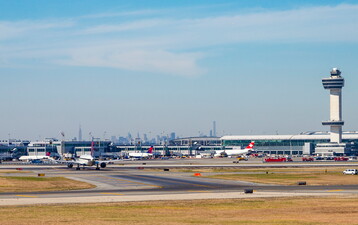NEW
Airport Decarbonization
In light of the net zero emission targets set by airports, there is a pressing need for the rapid and efficient implementation of measures aimed at reducing Scope 1-3 emission at airports (with focus on infrastructure, equipment and operations). Whether it is the shift towards eGSE utilization on the apron, the introduction of sustainable taxi modes for taxiing aircraft, or the decarbonisation of the energy grid: To fully leverage the reduction potential of carbon reducing technologies and processes, it is essential to initiate the necessary planning at the earliest possible stage. As the entire airport system is subject to a large variety of interconnected processes and interdependencies between stakeholders, the implementaiton of such decarbonisation measures can be costly and highly complex.
Some of these measures are mandated by regulatory requirements at the national or European Union (EU) level. For instance, the "Alternative Fuels and Infrastructure Regulation" (Regulation (EU) 2023/1804) is one such requirement, which will require the future deployment of electric ground power units at airports by 2030. It seems reasonable to assume that additional regulatory requirements will be introduced in the near future.
The objective of this training course is to provide a comprehensive overview of the measures for airport decarbonization and associated carbon reduction potentials. The measures are presented separately by airport area (landside, terminal, apron/airside) and categorized into three main groups:
- infrastructure adjustments,
- introduction of new equipment, and
- improving operational procedures
Furthermore, the course covers planning and implementation strategies, including CONOPS development and implementation roadmaps. The presented measures are illustrated by industry best practice, lessons learned, and case studies from airports.
The availability of renewable energy at the airport is a key facilitator for any sustainable and low-emission technologies and equipment. In light of the aforementioned considerations, the technical/aeronautical aspects of generating renewable energy at the airport (e.g. solar farms) are also addressed within the course. In addition, the course offers insight into the regulatory landscape, including present and future requirements (e.g., the New Green Deal/Fit-55 Package) and introduction to accreditation processes for carbon emissions accounting at airports (e.g., ACI Airport Carbon Accreditation).
Please note: This training course is offered in collaboration with Dornier Consulting International GmbH.
Course Details
Location:In-houseLanguage:English
Duration:2 days
Provider:airsight GmbH
Course Content
Background: Impact of aviation activities on global climate and the environment around airports
Legal Framework & international/industry initiatives on sustainability in aviation
- EU Level regulatory requirements & Outlook
- Airport/Industry Net Zero Emission Targets
- ACI Airport Carbon Accreditation
Measures for airport decarbonization (infrastructure/equipment/operations)
- Landside / access
- Terminal
- Apron / airside
Renewable energy harvesting at airports (Wind, Solar and Geothermal Energy)
- Aeronautical, technical and biodiversity constraints, assessment methods, workflow strategies
- Energy demand & grid analysis
Implementation planning and roadmapping (incl. stakeholder engagement actions)
Green Financing
Trainer
Christoph Struempfel-Seifert, M.Sc.
Head of airsight’s Sustainable Aviation department
Mr Struempfel-Seifert is an expert for sustainable aviation and is responsible for all project tasks related to sustainable aviation and environmental protection at airports. Furthermore, he is an appreciated trainer, sharing his knowledge and practical experience with other national and international aviation experts.
After graduating as Master of Science in Aeronautics and Astronautics from the Technical University of Berlin, he worked as a research assistant and lecturer at the Chair of Flight Guidance and Air Transport at the TU Berlin. In his scientific career, he focused on modelling aircraft noise and emissions, UAS noise measurements and calculation as well as the optimization of flight procedures with respect to environmental and eco-efficiency targets.
For airsight, he has conducted several environmental assessments, noise and emissions studies for various airports in Germany, Luxembourg, United Arab Emirates, Romania and the Philippines. As a recognized SME for aircraft noise modeling, he has extensive experience with the FAA's Aviation Environmental Design Tool (AEDT).
A second major focus of his work is to support international airports on their decarbonization journey with detailed studies on renewable energy, in particular the implementation of solar energy systems, including Singapore-Changi, Berlin, Cologne, Düsseldorf, Stuttgart and various other airports. His team is helping airports meet the challenges of the future through new, sustainable technologies, such as sustainable aircraft taxiing and e-GSE implementation.
Tine Haas
Ms Haas works as Director Airports Aviation Business Line Mobility at Dornier Consulting International GmbH.
Target Group
This training course is designed for a diverse audience, including
- Airport operators,
- Ground service provider,
- Airlines,
- ATC/ANSPs,
- Equipment supplier,
- construction companies,
- government/regulatory bodies, and
- other stakeholders (such as local transportation companies for landside access).
Organisational Details
airsight offers this training course on request, worldwide. At the end of the course, all participants will receive an airsight certificate based on EASA training regulations, which is highly recognised throughout the aviation industry.
About airsight Training
airsight Training course quality
airsight operates an ISO 9001 certified Quality Management System and pursues the objective to provide high quality services that fully meet the clients’ needs.


 Training 5 or more people? Ask for an In-house course at your premises or online!
Training 5 or more people? Ask for an In-house course at your premises or online!


